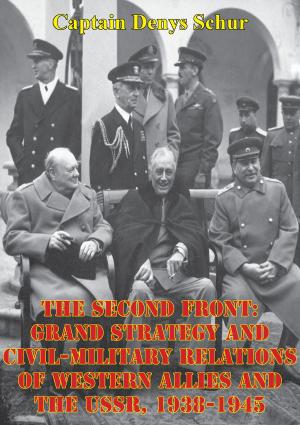The Geopolitical Curse of the Caucasus
Nonfiction, Social & Cultural Studies, Political Science, International, International Relations, History| Author: | Nodar Gabashvili | ISBN: | 9788868556815 |
| Publisher: | Nodar Gabashvili | Publication: | September 11, 2013 |
| Imprint: | Language: | English |
| Author: | Nodar Gabashvili |
| ISBN: | 9788868556815 |
| Publisher: | Nodar Gabashvili |
| Publication: | September 11, 2013 |
| Imprint: | |
| Language: | English |
At the beginning of the book the author intended to explain the reasons of the break up of the USSR, which was necessary to understand well subsequent events in the Caucasus. The author writes of the most important aspects of the policy towards ethnical minorities in the Caucasus by the Tsarist autocracy and the Soviet Communist state. It was necessary to understand well the strategy in the region of Russian post soviet leaders Yeltsin and Putin, after the break up of the USSR. In this manuscript the author made an effort to elucidate the reasons, particularities and consequences of the conflicts in the post Soviet South Caucasus and, first of all in Chechnya and Georgia. He also intended to show that the conflicts in Mountainous Karabakh, South Ossetia, Abkhazia and Chechnya, the separatist regions of the Caucasus, were the events linked between them. The fact is that after having used the democratic and liberal movements of Georgia, of Baltic states and of Russia as a measure to dismantle the Soviet Communist party and the Soviet state, Yeltsin, the president of Russian Federation, began Russia’s traditional policy of dominance of the South Caucasus. The dominance of the South Caucasus and other parts of the former USSR was a measure to confirm the Great power status, a policy necessary to aliment Russian imperial nationalism, used it as a substitute of the communist ideology. Being a historian and journalist, the author gives an analysis of many materials on the subject written in various languages. The fact that the author was a witness to many events in the Caucasus is an opportunity for readers of this book a to better understand the events that are little known so far. This is why some aspects of the events in the region, like those of Georgia, are subjected to a kind of conspiracy of silence. The theme of the Caucasus is important, since the so-called frozen conflicts in the Caucasus, such as in the Mountainous Karabakh, could erupt at any time, which could involve Russia, Iran and Turkey. The author of this book is a journalist and historian from Georgia, which once was one of the republics of the Soviet Union. He participated in the independence and liberal movement of Georgia that won in 1991 the first multiparty elections. He became a Vice Minister of Foreign affairs of the government that declared independence of Georgia from the USSR. After the removing by force of this government he was forced to leave his native country. From 1995 he lived in Rome at first under protection of Vatican and then he was granted political asylum from Italy. Im Italy he has published several a books on history and international relations: “Caucasus and Yugoslavia: Forgotten Wars and Precarious Pacifications“. Stango Editore. 2001, Rome; “Georgia and Rome. 2000 Years of Dialogue between Christians“. Libreria Vaticana, 2003. Rome.
At the beginning of the book the author intended to explain the reasons of the break up of the USSR, which was necessary to understand well subsequent events in the Caucasus. The author writes of the most important aspects of the policy towards ethnical minorities in the Caucasus by the Tsarist autocracy and the Soviet Communist state. It was necessary to understand well the strategy in the region of Russian post soviet leaders Yeltsin and Putin, after the break up of the USSR. In this manuscript the author made an effort to elucidate the reasons, particularities and consequences of the conflicts in the post Soviet South Caucasus and, first of all in Chechnya and Georgia. He also intended to show that the conflicts in Mountainous Karabakh, South Ossetia, Abkhazia and Chechnya, the separatist regions of the Caucasus, were the events linked between them. The fact is that after having used the democratic and liberal movements of Georgia, of Baltic states and of Russia as a measure to dismantle the Soviet Communist party and the Soviet state, Yeltsin, the president of Russian Federation, began Russia’s traditional policy of dominance of the South Caucasus. The dominance of the South Caucasus and other parts of the former USSR was a measure to confirm the Great power status, a policy necessary to aliment Russian imperial nationalism, used it as a substitute of the communist ideology. Being a historian and journalist, the author gives an analysis of many materials on the subject written in various languages. The fact that the author was a witness to many events in the Caucasus is an opportunity for readers of this book a to better understand the events that are little known so far. This is why some aspects of the events in the region, like those of Georgia, are subjected to a kind of conspiracy of silence. The theme of the Caucasus is important, since the so-called frozen conflicts in the Caucasus, such as in the Mountainous Karabakh, could erupt at any time, which could involve Russia, Iran and Turkey. The author of this book is a journalist and historian from Georgia, which once was one of the republics of the Soviet Union. He participated in the independence and liberal movement of Georgia that won in 1991 the first multiparty elections. He became a Vice Minister of Foreign affairs of the government that declared independence of Georgia from the USSR. After the removing by force of this government he was forced to leave his native country. From 1995 he lived in Rome at first under protection of Vatican and then he was granted political asylum from Italy. Im Italy he has published several a books on history and international relations: “Caucasus and Yugoslavia: Forgotten Wars and Precarious Pacifications“. Stango Editore. 2001, Rome; “Georgia and Rome. 2000 Years of Dialogue between Christians“. Libreria Vaticana, 2003. Rome.















